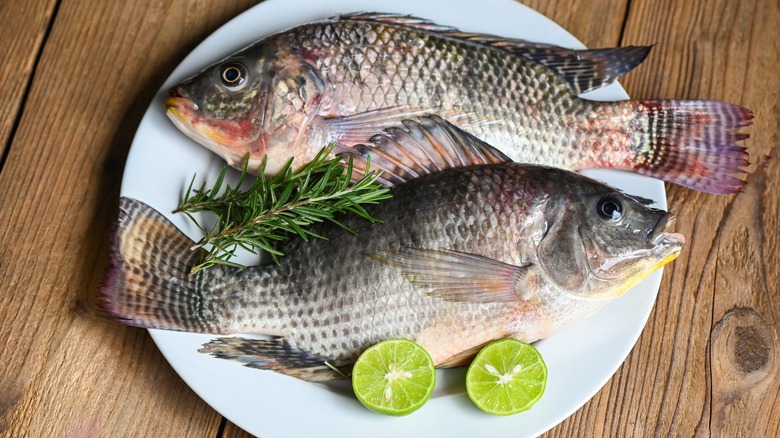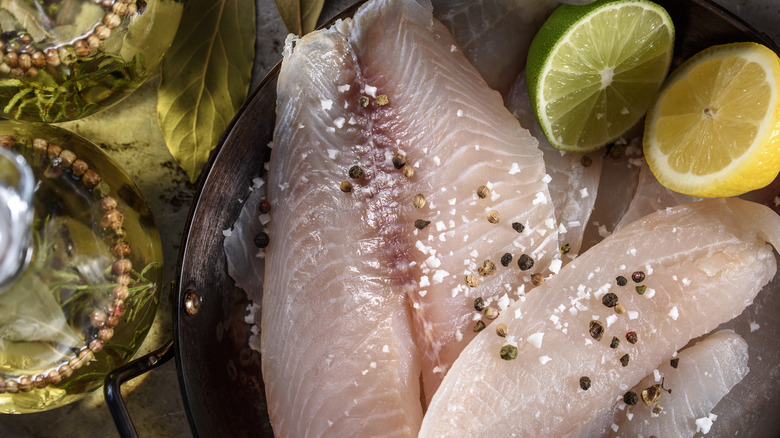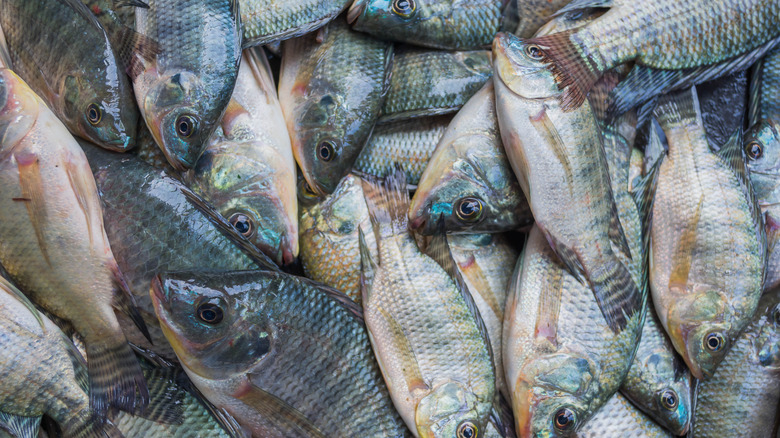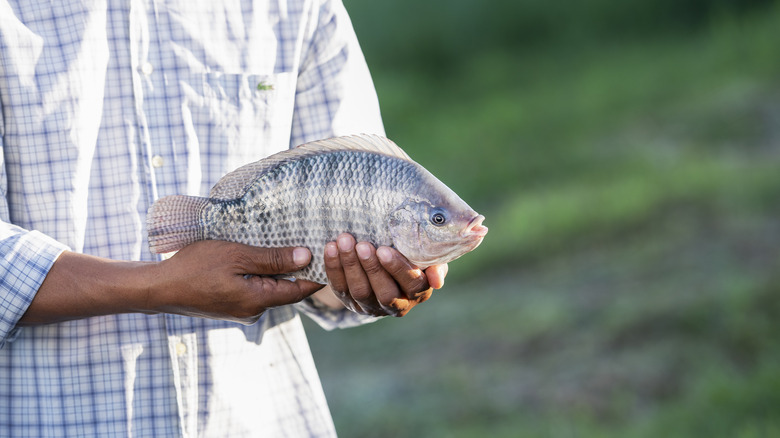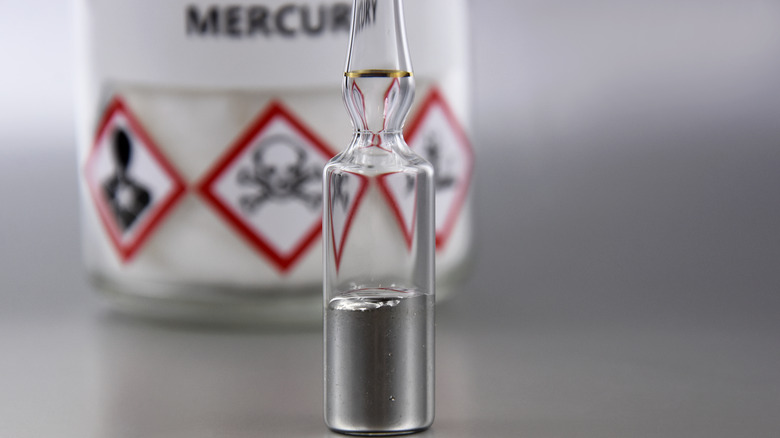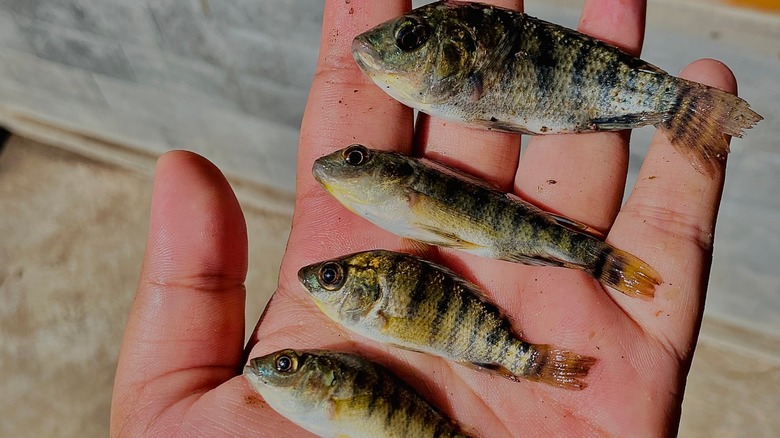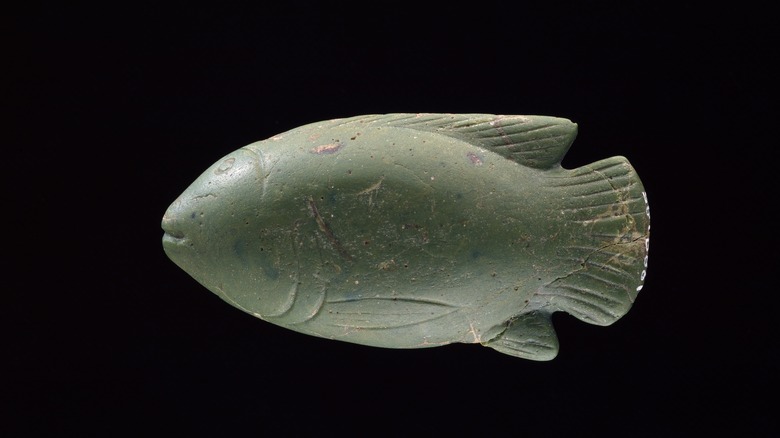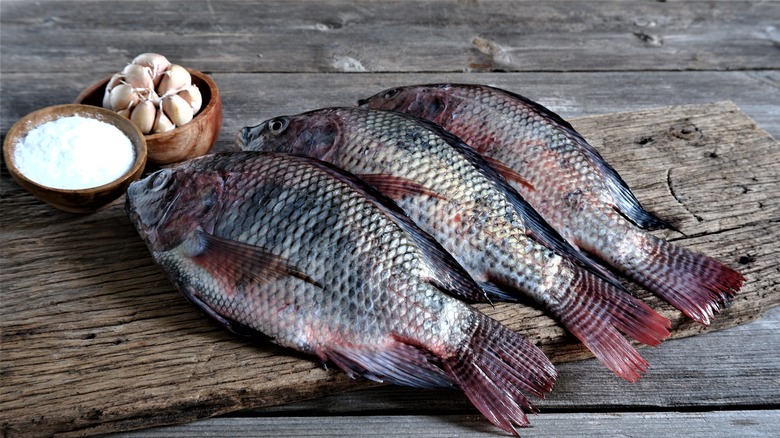What You Should Know Before You Eat Tilapia Again
You've seen packaged filets of tilapia — a non-threatening white fish — stacked high in the freezer section of any grocery store you've passed through. You've probably even had it while eating out, without necessarily realizing it. It appears to be a much cheaper fish option when compared to things like tuna, salmon, swordfish, and even cod, on occasion. In a world where we're all trying to eat healthier and more sustainably, this less-expensive seafood seems like a good option, right?
But recent years have seen smatterings of accusations thrown at this fish. Unsustainable farming practices, poop-filled eating habits (yes, really), and even claims of tilapia being unhealthy have all swirled in the headlines, leaving us wondering if we really should be eating this fish. From how it's farmed to navigating different varieties to understanding its health and wellness benefits, here we've rounded up everything you need to know about tilapia and why it should be part of your meal rotation.
Tilapia is among the most-eaten fish
Amongst all the wacky reports about tilapia in the last few years related to being farmed unsustainably, eating farm runoff (literally poop, according to some), and being worse for you than bacon, it still holds a spot as one of the most consumed fish in the world. According to The Healthy Fish, tilapia is the fourth-most eaten fish in the United States, with folks chowing down on the mild white fish in the ballpark of about 440 million pounds per year — which equates to roughly 1.38 pounds per person. Unsurprisingly, it was beaten out by salmon, shrimp, and tuna, but holds its fourth place spot likely due to its incredible versatility, availability, and cheaper price tag.
Tilapia beat out pollock and cod here in the U.S., so it seems to be the white fish of choice for most Americans. It's easy to cook, freezes well, and can be bought in bulk.
Most tilapia comes from overseas
Farming tilapia is a massive operation, and the United States imports the vast majority of this fish for consumption. The main exporters of tilapia are China, Egypt, Indonesia, Thailand, and Brazil, where farming the fish is a huge business. According to Hatchery Feed & Management, China's chokehold on the top spot is due to a few factors. First, government support of and building of mass infrastructure to farm tilapia has allowed for a huge expansion of the practice in recent years. Secondly, when tilapia farming first began in China in the 1960s, the fish served as an excellent option for common people looking for cheap animal protein. The demand has shifted away from a domestic need to an international one since the early 2000s.
Consumers of tilapia may want to avoid tilapia farmed in China, though. According to Healthline, Monterey Bay Aquarium's Seafood Watch had previously reported that toxic chemicals were being used in Chinese tilapia farming — including several that had been banned. There were — and are still — reports, too, of farm runoff, mainly animal feces, being used in feeding tilapia in China, giving fuel to the poop rumors. So, all in all, although you may be hard-pressed to find wild-caught or even domestically farmed tilapia, it's best to steer clear of the fish raised in China.
The skin is super useful
One of the pretty cool things about tilapia is their skin and its usefulness in the medical world. According to Scientific American, doctors in Brazil have recently begun turning to tilapia skin to help in the treatment of second and third-degree burn victims. The reason is twofold. First, although many other countries use human or pig skin to treat those in need, Brazil lacks enough of a supply of either to meet the medical needs and demand. Second, Brazil is one of the largest exporters and farmers of tilapia in the world, making the fish readily available.
Doctors began experimenting with the scaly skin of the white fish, which can be placed on the area of injury and left on after being sterilized; unlike gauze and bandages which must constantly be changed. The tilapia skin helps with pain and seems to promote healing more quickly. The breakthrough likely wouldn't be utilized in larger, more affluent countries, but is promising for smaller developing countries, where clinical trials are being run to assess a path forward.
Tilapia is packed with protein
When it comes to health benefits, tilapia is a good choice — as is most seafood. Despite being a very low-calorie fish, tilapia packs a good amount of protein; about 26 grams in a 3.5-ounce serving. Thanks to the popularity of keto and other high-protein diets, tilapia is something that can easily fit into your healthy weeknight meal rotation.
If you're looking for an easy and healthy way to cook tilapia before or after your trip to the gym, you could try this easy sheet pan smoked paprika recipe. The fish is seasoned with smoked paprika, garlic powder, cumin, salt, and pepper and then cooked alongside corn, red bell pepper, and broccoli. The fiber from the vegetables will keep you full, and the protein from the tilapia is sure to keep you from raiding the pantry in an hour. Plus, this dish clocks in at only 184 calories per serving — talk about a protein powerhouse. If you're in the mood for a meal with a bit more to it, you can always opt for something like this blackened pan-seared tilapia with mango salsa, which can be served alongside a hearty portion of rice and black beans. You can even go sort-of Italian with it and opt for a Parmesan baked tilapia. Really, the possibilities are endless.
It's an incredibly versatile fish
No matter what dish you're in the mood for, it's likely that tilapia can help you get where you want. The mild, white fish is incredibly versatile, is easy to cook, and comes together quickly, making it a savior on busy weeknights and for those less inclined to know their way around the kitchen.
Like chicken, tilapia easily adapts to whatever seasoning or treatment you throw at it. It's no wonder, then, that it's incredibly popular in eateries and restaurants looking to easily scale up recipes while keeping food costs low; you can spend more money on good ingredients to enhance and lift the taste of the fish without worrying about ruining the flavor — like a swordfish, ahi tuna, or even salmon.
If you're looking to try your hand at home with an easy tilapia recipe, you could try a classic baked almond-crusted tilapia, utilizing a blanched almond and breadcrumb dredge flavored with herbs and spices. The fish is quickly baked and works wonderfully alongside lemony potatoes and a light salad.
Low mercury is a trademark of tilapia
For those watching their mercury intake but still craving seafood — especially pregnant women — tilapia checks the box. A lot of seafood has higher levels of mercury, which can be especially problematic for those with health issues or unborn children. Many fish absorb mercury through their gills after it's been created in the atmosphere via industrial practices. It eeks into water supplies, where it's absorbed by sea life.
Higher levels of exposure to mercury — especially ingesting it via seafood — can lead to health issues such as nervous system damage, kidney damage, liver damage, and immune system damage. Pregnant women are especially at risk since the damage can be passed to a developing fetus, where it can affect the brain and nervous system as it develops.
Tilapia traditionally have a much lower mercury content than wild-caught seafood since the majority of them are farmed in closed ponds and lakes, making it easier for farmers to control what gets into their water supply.
There are three main commercial varieties of tilapia
Tilapia is sort of a catch-all term, and doesn't necessarily apply to just one type or variety of fish. There are three main commercial varieties of tilapia and over 100 different species. The kind you're most likely to come into contact with are the Nile, Blue, and Mozambique.
The Nile tilapia is native to northern Africa, sports a brownish-grey color, and is probably the most popular and recognized variety. Most of the tilapia imported into the United States is Nile tilapia, as they tend to be the most successfully farmed variety. These tilapia usually weigh between 9 and 10 pounds, full-grown.
The Blue tilapia is native to the Middle East as well as northern Africa and, as the name implies, has blueish scales. It's smaller than the Nile tilapia, which is nearly double its size; Blues usually weigh about 5 or 6 pounds. This variety is fairly tolerant of salt water, too, unlike the Mozambique or Nile.
Lastly, the Mozambique tilapia hails from southern Africa and flashes about in olive-grey scales. It's the smallest of the three tilapia varieties and usually tops out around 2.5 pounds. It's not frequently farmed, although there are several hybrids of Mozambique with both Nile and Blue tilapia.
It's full of B12, but not omega-3s
In terms of healthy oils, fats, and supplements, seafood — as a rule — can be a wonderful option to hit your daily intake needs. Salmon is a powerhouse for omega-3s, crabs are rich in zinc, and tuna sports high amounts of calcium. Tilapia, too, has its benefits in terms of vitamins and minerals that can help your body operate at its best. Tilapia has high levels of selenium, B12, niacin, phosphorus, and potassium. B12 is known to help with cognitive function, aiding our brains with memory and helping to stave off age-related decline. Phosphorus is an agent that helps our bones retain their strength — much like calcium — and tilapia has about 20% of the recommended daily intake. Selenium abounds in tilapia — a 3.5-ounce serving of the fish contains as much as 78% of your recommended daily intake. Selenium gives our immune systems a boost and helps protect cells from damage.
Tilapia does not, however, sport the high levels of omega-3 fatty acids found in other fish. In fact, it has about 10 times less than a piece of salmon. These fatty acids help fight inflammation and are great for heart health. Tilapia has omega-6 fatty acids, which some believe can be harmful to your health.
Most tilapia is farmed
As we've been hinting at throughout, finding wild-caught tilapia the way you'd find wild-caught salmon or other seafood is pretty difficult. This is because the vast majority of tilapia is farm-raised, mostly in places like China, Indonesia, and Brazil, although more than 120 countries have major farming operations for tilapia. Although well-done and sustainable farming practices for fish and animals are not all bad, most health experts warn consumers to steer clear of farmed seafood and try to use their dollars on wild-caught varieties of fish. This is mainly due to shady farming practices where farmed fish — like tilapia — can be fed things like farm runoff, corn, soy, refuse, and other not-so-great items. The general rule for farming is to feed animals and fish things that they'd be eating in their natural environment.
Another reason farmed seafood can be seen as less than desirable is that it exists in a closed ecosystem. In the wild, tilapia can swim in clean, natural habitats. In a closed farm pond or lake, they're forced to exist in what can sometimes become a dirty, stress-filled environment. There are, of course, many misconceptions about farm-raised fish, so, in the end, it's important to do your research and look for fish raised in sustainable environments that are fed a good diet. The healthier the fish, the better for you.
It could help in your anti-aging fight
If you're in the market for wrinkle creams, botox, and other means of showing the cool kids that you absolutely know what "cheugy" and "no cap" means, then tilapia may be able to help. In the constant fight against aging, antioxidants, vitamins, and minerals all play a part as do the foods we eat. Tilapia, rather surprisingly, is one of the foods you should look into adding to your weeknight meal rotation if you simply can't bear to spend another $50 on eye cream.
Tilapia has a variety of minerals that can help with skin elasticity and aid in activating other vitamins. Selenium — of which tilapia has about 78% of the recommended daily intake — helps to "turn on" the vitamin E and vitamin C in our bodies, which can greatly help in battling free radicals and aiding in the brightness and health of skin. Additionally, tilapia is rich in collagen, which can up our skin's moisture and add thickness to our skin, making it better able to battle signs of aging.
This fish is old
With roots in the Middle East and Mediterranean, it's perhaps not too surprising that tilapia can be found referenced in antiquity — from walls of the pharaohs' tombs to holy books like the Bible. According to Electrum Magazine, the ancient Egyptians actually farmed tilapia in large cordoned-off ponds much like we do today, making it one of the first cultivated fish. Additionally, the ancient Egyptians prized tilapia for their perceived powers over fertility, which could be related to female tilapia holding their young in their mouths — a symbol of rebirth to the ancients. The Egyptians even gave tilapia their own hieroglyph, and numerous amulets and charms have been found depicting tilapia. Pregnant women in ancient Egypt have been found, too, with tilapia amulets close by.
It is also widely believed that tilapia may have been the fish portrayed in the Bible as the one multiplied for the crowds by Jesus during his sermon. Regardless of what you believe, it's easy to see that tilapia has been an important part of the human eating experience for millennia.
You've probably eaten it without realizing
Even if you don't think you've ever tasted tilapia, chances are, you may have. According to CNN, fish fraud is fairly common at grocery stores, fish markets, and even restaurants. For example, consumers may think they're ordering or buying something like sea bass or snapper, which often commands a fairly hefty price. Those conducting the tests found that 55% of the time, sea bass was mislabeled, and about 42% of the time snapper was mislabeled, with many of these incidents seeing fish like tilapia, Dover sole, and even perch subbed in for the more expensive white fish.
There were also reports that tilapia had been subbed in for cod — both Atlantic and Pacific varieties — by Oceana. If you're a little nervous now about your seafood being mislabeled, large chain grocery stores seem to be some of the most trustworthy, so, there's yet another excuse to eat at home, up your culinary prowess, and whip up something at your own kitchen stove instead of eating out.
No, it's not a frankenfish
You may have heard tilapia referred to as a genetically modified "frankenfish"; that it's boneless, skinless, pumped full of chemicals, and overall a bad choice for you when it comes to seafood. According to Lakeway Tilapia, "at no time has the U.S. Government approved a genetically modified tilapia for sale to the public. There are absolutely no genetically modified tilapia being farmed for human consumption in the U.S. The only genetic modifications to tilapia are being done in Europe to "red Nile" tilapia, and again, they are not intended for human consumption."
So, although tilapia from overseas may be fed GMO ingredients like corn or soy, the fish itself are not genetically modified. There are, however, Genetically Improved Farmed Tilapia (GIFT) do exist, and have been bred to have more desirable traits. They may be larger, become mature faster, and overall aid in a fish farmer's quest to more quickly get the fish to market, leading to better profit margins. So, if you see claims that tilapia are boneless, skinless, GMO frankenfish hatched by scientists and not meant for human consumption, the claims are simply not true.
